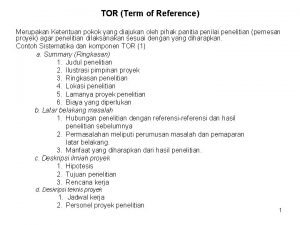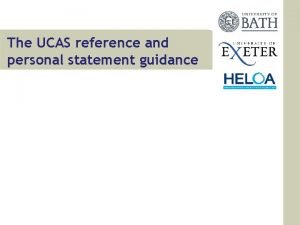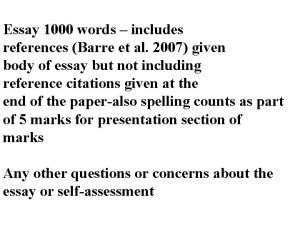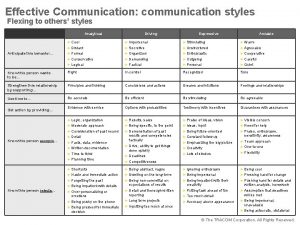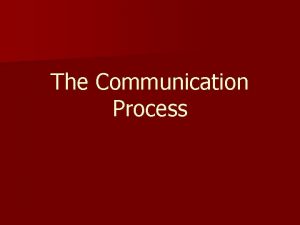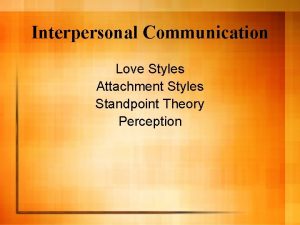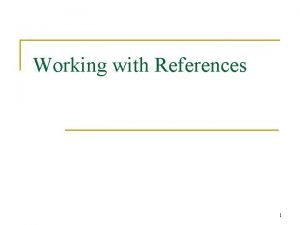COMMUNICATION STYLES Tumaini University KCMC REFERENCES Communication styles





























- Slides: 29

COMMUNICATION STYLES Tumaini University, KCMC

REFERENCES � Communication styles table (2009). http: //www. drbackman. com/communicationstyles. htm � Mc. Cabe M. , & Timmins (2006). Communication Skills for Nursing Practice. pp. 119 -130.

LEARNING OBJECTIVE � By the end of this session, students should be able to: ◦ Explain and demonstrate the different basic communication styles

WHAT IS COMMUNICATION? � Effectively imparting or exchanging information or news �A means of connection between people or places

INTRODUCTION � People communicate with each other in different ways. Someone may be passive and not stand up for themselves, or aggressive and attempt to run over other people, or be passive-aggressive and smile to someone’s face while sabotaging them behind their back. In order to build healthy relationships, we must learn to be assertive: clear, direct, and respectful in our communication.

WHY IS IT IMPORTANT TO COMMUNICATE WELL?

VERBAL VS NONVERBAL COMMUNICATION � Verbal communication is… ◦ The process of using sounds and language to relay information � Nonverbal communication is… ◦ The process of communication through sending and receiving wordless cues

NONVERBAL COMMUNICATION � Types of nonverbal communication? ◦ General appearance ◦ Body language �Eye contact �Posture �Expressions �Gestures ◦ Touch ◦ Tone of voice ◦ Proximity � Nonverbal culture communication norms vary by

NONVERBAL COMMUNICATION � Why is nonverbal communication important? ◦ Used to repeat a verbal message �Ex. When giving directions, point to where you are talking about ◦ Complement a verbal message �Ex. Your boss patting you on the back while giving you praise ◦ Contradict a verbal message �Ex. Saying you’re excited to see someone while frowning ◦ May substitute for a verbal message �Ex. Finger to lips to tell someone to be quiet ◦ May accent a verbal message �Ex. Pounding a table may show you are passionate about your message

NONVERBAL COMMUNICATION Confidence!

FOUR BASIC COMMUNICATION STYLES 1. 2. 3. 4. Passive Communication Aggressive Communication Passive-Aggressive Communication Assertive Communication

1. PASSIVE COMMUNICATION � Individuals don’t honestly express their opinions or feelings � OR expressing thoughts in an apologetic way, so that others easily disregard them � Thinks “My thoughts, needs, and feelings are less important than yours. ” � Can cause or be a result of low self-esteem � Want to avoid conflict, so grievances mount and build up, and may result in explosive outbursts, after which they feel shame and guilt and return to being passive.

1. PASSIVE COMMUNICATION � What characteristics would you expect to see in a passive communicator? ◦ ◦ ◦ ◦ Hesitant; fail to assert themselves Quiet, speak softly Apologizes: “I’m sorry to bother you…” Self-dismissal: “It’s not important” Crosses arms Avoids eye contact Allow others to infringe on their rights

2. AGGRESSIVE COMMUNICATION � Individuals express their feelings and opinions and advocate their needs in a way that violates the rights of others. � Aggressive communication involves manipulation-these communicators are verbally and/or physically abusive. � Superiority is maintained by putting others down.

2. AGGRESSIVE COMMUNICATION � What characteristics would you expect to see in an aggressive communicator? Try to dominate others Use humiliation to control others Criticize, blame, or attack others Have low frustration tolerance Speak in a loud, demanding voice Aggressive body language Sarcastic, harsh language Uses put-downs (“don’t be so stupid”) or threats (“you better watch out”) ◦ Expresses opinions as facts ◦ ◦ ◦ ◦

2. AGGRESSIVE COMMUNICATION �Aggressive communicators: ◦ Become alienated from others, create enemies ◦ Generate resentment in others ◦ Blame others instead of owning their issues ◦ Relationships are based on negative emotions and are therefore unstable

3. PASSIVE-AGGRESSIVE COMMUNICATION � Individuals avoid direct confrontation (passive) but attempt to get even through manipulation (aggressive). � Individuals come off as passive but are really trying to get what they want in a subtle, indirect, or underhanded way.

3. PASSIVE-AGGRESSIVE COMMUNICATION � What characteristics would you expect to see in a passive-aggressive communicator? ◦ Mutter to themselves rather than confront a person or issue ◦ Have difficulty acknowledging their anger ◦ Use facial expressions that don’t match how they feel ◦ Deny that there is a problem ◦ Appear cooperative while purposely doing things to annoy and disrupt ◦ Use subtle sabotage to get even

3. PASSIVE-AGGRESSIVE COMMUNICATION � Do you have an example of a passiveaggressive interaction? � Prisoners of War (POW): often act in passiveaggressive ways to deal with feelings of powerlessness. Outwardly, to the guards, POWs are cooperative, but secretly sabotage the prison or disrupt the prison system.

4. ASSERTIVE COMMUNICATION � What does it mean to be assertive?

4. ASSERTIVE COMMUNICATION � Individuals clearly communicate feelings, thoughts, and beliefs in an open, honest manner that does not violate the rights of others. � Assertive communication comes from high self-esteem. � Assertive communicators value themselves, their time, and their needs and advocate for themselves while being very respectful of the rights of others.

4. ASSERTIVE COMMUNICATION � We naturally express ourselves assertively when our self-esteem is intact, allowing us to communicate without games or manipulation. � Assertive communication is the most effective and healthiest form of communication, but is the style people use least often.

4. ASSERTIVE COMMUNICATION � What characteristics would you expect to see in an assertive communicator? ◦ ◦ ◦ ◦ ◦ State needs and wants clearly and respectfully Use “I” statements Communicate respect for others Listen receptively without interrupting Uses cooperative phrases: “What are your thoughts on this? Thinks “I won’t allow you to take advantage of me and I won’t attack you for who you are. ” Voice is appropriately loud for the situation Body language is open. Facial expressions are congruent with words.

4. ASSERTIVE COMMUNICATION � The assertive communicator behaves in a way that says: ◦ We are equally entitled to respectfully express ourselves. ◦ I am confident about who I am. ◦ I can’t control others but I can control myself ◦ I am responsible for my own happiness. ◦ I place a high priority on having my rights respected

4. ASSERTIVE COMMUNICATION � Is being assertive easy? � Why can it be difficult at times to behave assertively? � Can you think of a time when you behaved assertively? Or a time when you wish � you had behaved assertively but didn’t?

ROLE PLAY OF COMMUNICATION STYLES � Two volunteers: One boss and one nurse or physiotherapist � Nurse/physiotherapist to ask boss for a day off, in three different ways: passive, aggressive, and assertive. � Class: direct nurse/physiotherapist how to be passive, aggressive, and assertive. What is the body language like? Tone of voice? How do they act?

ROLE PLAY OF COMMUNICATION STYLES � Which of the communication styles seemed to be most effective? � What role did body language play in the communication style used? � How did you feel when observing each of the communication styles?

SMALL GROUP ACTIVITY how you would typically react in each of these situations. Identify the communication style used for your reaction to each situation. If your initial reaction is not assertive, how could you respond assertively? � How do you respond when…. � Discuss 1. 2. 3. 4. 5. 6. Everyone leaves the dish washing up to you? You want to say “no” to a child’s request? You want to say “no” to a proposed visit by a relative? A friend wants to borrow something that you need? You feel angry at the way a friend has treated you? Someone is criticizing someone who is important to you? 7. You return a borrowed item that has broken? 8. You receive legitimate criticism from your boss? 9. You receive unfair criticism from your boss?

REFERENCES L. (2013). Why communication in the nursing profession is important. Retrieved from http: //www. nursetogether. com/why-communicationin-the-nursing-profession-is-important � Dulwich College Suzhou. (2012). The characteristics of passive, aggressive, and assertive communication. Retrieved from https: //www. dulwichsuzhou. cn/uploaded/DCSZ_meet_the_counselor/The_ Characteristics_of_Passive, _Aggressive_and_Assertive _Communication. pdf � Mc. Cabe, C. , & Timmins, F. (2006). Communication Skills for Nursing Practice. New York, NY: Palgrave Macmillan. � Anderson,
 Studi kepemimpinan universitas iowa
Studi kepemimpinan universitas iowa Personal profile statement
Personal profile statement Tor terms of reference adalah
Tor terms of reference adalah Ucas reference example
Ucas reference example Lister
Lister References apa format
References apa format How to put references on a poster
How to put references on a poster References of money and banking
References of money and banking The difference between reference and bibliography
The difference between reference and bibliography Example of intertext
Example of intertext Unclear pronoun reference
Unclear pronoun reference Waste management references
Waste management references Ibm iseries external storage
Ibm iseries external storage Skin burns
Skin burns Four figure grid reference examples
Four figure grid reference examples Contextual reference meaning
Contextual reference meaning Contextual reference
Contextual reference Difference between reference and bibliography
Difference between reference and bibliography Dejobbing
Dejobbing References of performance appraisal
References of performance appraisal Building references
Building references Ic design references
Ic design references Examples of allusion in fahrenheit 451 part 1
Examples of allusion in fahrenheit 451 part 1 Bibliography vs references
Bibliography vs references What is a six figure grid reference
What is a six figure grid reference Intertextual references in riptide
Intertextual references in riptide Abstract page apa
Abstract page apa Shawshank redemption bible quotes
Shawshank redemption bible quotes Swedbank internetbanka konta pārskats
Swedbank internetbanka konta pārskats Contextual criticism art
Contextual criticism art


